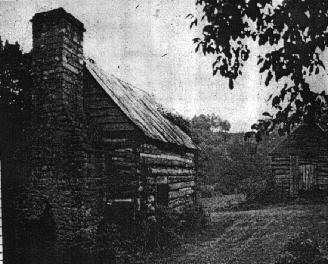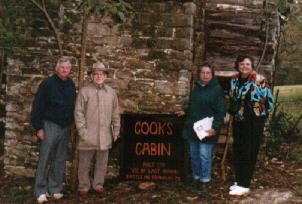PIONEER LOG HOUSE
COUSINS MEET


| Dr. Maurice G. Cook, Raleigh, NC | |
| Chas. L. Cook, Lexington, KY | |
| Bettie Sue Cook Wells, Shelbyville, KY | |
| Pat Cook Sengstock, Wheaton, IL | |
| Oct. 25, 1997 |
COOK’s CABIN
Franklin Co., KY
Symbolic of Heroic Pioneer Days
|
PIONEER LOG HOUSE |
COUSINS MEET |
||||||||||
 |
 |
||||||||||
| Cook's Cabin, built 1791, site of last Indian Battle in Franklin County, KY |
|
The pioneer log house known as Cook’s Cabin has been a topic of conversation in Franklin County, Kentucky for many years. "In 1986, Franklin County historian, William B. Scott, Jr. surveyed the site and he said the site was a ‘unique example of a cluster of log and early frame structures that appear to date from the 1st quarter of the Nineteenth Century (early 1800s). Only such example in Franklin County." (The State Journal, Frankfort, Kentucky, October 23, 1997, by Dave Baker, Page 2-Section A).
The cabin is identified with a sign that was made by the local Boy Scouts: COOKS CABIN, BUILT 1791, SITE OF LAST INDIAN BATTLE IN FRANKLIN CO.David Morgan, head of the Kentucky Heritage Council, noted the site is on Kentucky’s list of historic sites, and is eligible for National Historic Registration status. (The State Journal, Frankfort, Kentucky, October 23, 1997, by Dave Baker, Page 2-Section A).
"Bill Macintire, a Kentucky Heritage Council expert on log structures, said he doubted the cabin was constructed in 1791. However, the cabin appeared to have been built before 1810, he said. Macintire based his estimate on nails found inside the building. Nails in the earliest pioneer settlements were hand-made. Nails found in the log cabin appear to be both hand-wrought and machine stamped." (The State Journal, Frankfort, Kentucky, October 23, 1997, by Dave Baker, Page 2-Section A).
The Kentucky Heritage Council displayed Cook’s Cabin in a brochure for the 1998 Kentucky State Fair Exhibit. "Cook’s Cabin would most likely have been considered a ‘house’ when it was built, although from today’s perspective it looks like a cabin. It is an unusual survival of a relatively unaltered single pen log structure that may have originally been a kitchen (also sometimes called a ‘cookhouse’) or a dwelling. One unusual feature of the house is that the logs were left round on the exterior and hewn flat inside. The house was weatherboarded sometime in the early to mid 1800’s.
"Today, the distinction between ‘house’ and ‘cabin’ remains to some degree, but has changed over time. Buildings such as Cook’s cabin, which would have once been called houses, are often called cabins now. Today, we no longer build cabins for survival. Instead, we build them for hunting lodges, vacation houses, or wooded retreats. Such buildings, often equipped with plumbing and electricity, are far from the crude pioneer cabins of the 1700s." (The Pioneer Log House in Kentucky by William J. Macintire).
Nellie Glenn, a reporter, gave a vivid description of the cabin when she visited in 1976."It stands in remarkably good condition in a lush, green valley just above the creek. Its weather-beaten logs lay plumb, unmarked by decay or insects. When confronted with such a genuine, practically untouched link with the past, a nostalgic feeling for the rich challenge of pioneer life is likely to envelope you and the imagination almost becomes the real. Through the humid, noon-day heat of the hazy summer’s day came the incessant drone of insects, the call of song birds and the distant lowing of cattle. The gentle lapping of Elkhorn’s sparkling waters upon the rocky shore joined the refrain, producing an almost mesmeric effect upon the listener. A party of Indians could have sneaked upon this homestead with comparative ease.
"On the exterior of the cabin a large, beautifully-constructed chimney occupies almost all of one end of the house, but the original roof has been replaced by one of tin; and, small wonder, when its history becomes known. Inside, on the right-hand side of the fireplace is a small window which was left open to admit light and air in the summer and over which animal skins were fastened to keep out bitter cold in winter. To the left of the fireplace is the remainder of the ladder that reached to the loft, which no longer exists. Originally, the cabin must have had two doors, but one is now boarded up to form another window. Concrete has been poured onto the floor, but several of the original puncheon logs still remain. Despite its emptiness and weather-worn condition, the little house still retains an air of cozy warmth, and an aura of well earned peace surrounds it." (Kentucky Register, June 18, 1976 by Nettie Glenn).
"In 1791 Jesse and Hosea Cook were living on land that was part of a 3,000 acre grant given by Virginia to the Church family for service performed during the Revolutionary War. Their cabins were within a stone’s throw of Elkhorn Creek and were part of the Innis Settlement (also, known as Cook Station). The Cooks had brought their families with a small group of mostly young married people, to the settlement around Christmas of that year." The State Journal, Frankfort, Kentucky, Nov. 28, 1971).
Cook’s Cabin stands today on a private farm on the banks of Elkhorn Creek. History books document the Indian Massacre of Hosea and Jesse Cook on April 28, 1792. "Female Heroism" was exemplified when a band of hundred Indians were fought off by their wives. "The story of their husbands’ ambush and their stalwart defense of their log cabin is the stuff of legends. The Cooks’ wives, according to historical accounts, faced unsuccessful tomahawk attacks and gunfire to the door of the cabin. One of the women, finding a lead musket ball too small to fit into the barrel of the household gun, bit the bullet in half then shot an Indian outside. The raiders tried to set the cabin on fire, according to published accounts. The women fought the rooftop fire with their available water, the smashed eggs and used the liquid to douse flames once the water ran out. As a last desperate measure, the women used the blood-soaked coat of one of the Cook brothers to quell the flames." (The State Journal, Frankfort, Kentucky, October 23, 1997, by Dave Baker, Page 2-Section A).
Jesse and Hosea Cook were sons of William Cook II and Margaret Jones who migrated to Franklin Co., Kentucky in 1784 from Henry Co. (now Franklin Co.) VA. Jesse married Elizabeth Bohannon in 1785 and Hosea married Elizabeth Edrington in 1791. Both of the wives were called "Betsy."
Chas. L. Cook, 2nd great-grandnephew [email protected]
Return to Main Cook Page / Census and County Page
Other related pages: Descendants of William Cook - Seth Cook - Rev. Joshua Flood Cook - Morgan's Raider's - William Miles Cook - Captain Smith Cook - Shelby Co, KY - Abraham C. Cook - Rev. Abraham Cook - William Cook I - Issac Marion Cook - The Indian Massacre of Hosea and Jesse Cook, April 28, 1792, KY - Will of William Cook - Will of Margaret Cook - Will of Seth Cook - William Cook Pilgrimage - Battle Hymn of the Cook's